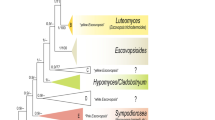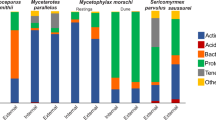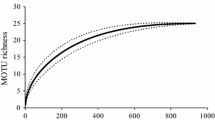Abstract
Fungus-growing “attine” ants forage diverse substrates to grow fungi for food. In addition to the mutualistic fungal partner, the colonies of these insects harbor a rich microbiome composed of bacteria, filamentous fungi and yeasts. Previous work reported some Trichoderma species in the fungus gardens of leafcutter ants. However, no studies systematically addressed the putative association of Trichoderma with attine ants, especially in non-leafcutter ants. Here, a total of 62 strains of Trichoderma were analyzed using three molecular markers (ITS, tef1 and rpb2). In addition, 30 out of 62 strains were also morphologically examined. The strains studied correspond to the largest sampling carried out so far for Trichoderma in the attine ant environment. Our results revealed the richness of Trichoderma in this environment, since we found 20 Trichoderma species, including three new taxa described in the present work (Trichoderma attinorum, Trichoderma texanum and Trichoderma longifialidicum spp. nov.) as well as a new phylogenetic taxon (LESF 545). Moreover, we show that all 62 strains grouped within different clades across the Trichoderma phylogeny, which are identical or closely related to strains derived from several other environments. This evidence supports the transient nature of the genus Trichoderma in the attine ant colonies. The discovery of three new species suggests that the dynamic foraging behavior of these insects might be responsible for accumulation of transient fungi into their colonies, which might hold additional fungal taxa still unknown to science.





Similar content being viewed by others
References
Atanasova L, Druzhinina IS, Jaklitsch WM (2013) Two hundred Trichoderma species recognized on the basis of molecular phylogeny. In: Mukherjee PK, Horwitz BA, Singh US, Mukherjee M, Schmoll M (eds) Trichoderma: biology and applications, 1st edn. CAB International, London, pp 10–42
Attili-Angelis D, Duarte APM, Pagnocca FC, Nagamoto NS, Vries M, Stielow JB, Hoog GS (2014) Novel Phialophora species from leaf-cutting ants (tribe Attini). Fungal Divers 65:65–75. doi:10.1007/s13225-013-0275-0
Augustin JO, Diehl E, Samuels RI, Elliot SL (2011) Fungos parasitas de formigas-cortadeiras e de seu fungo mutualístico. In: Della Lucia TMC (ed) Formigas cortadeiras: da bioecologia ao manejo, 1st ed. UFV, Viçosa, pp 284–311
Augustin JO, Groenewald JZ, Nascimento RJ, Mizubuti ESG, Barreto RW, Elliot SL, Evans HC (2013) Yet more “weeds” in the garden: fungal novelties from nests of leaf-cutting ants. Plos One 8:e82265. doi:10.1371/journal.pone.0082265
Bae H, Sicher RC, Moon S, Kim MS, Kim S, Strem MD, Melnick RL, Bailey BA (2009) The beneficial endophyte Trichoderma hamatum isolate DIS 219b promotes growth and delays the onset of the drought response in Theobroma cacao. J Exp Bot 60:3279–3295. doi:10.1093/jxb/erp165
Bailey BA, Melnick RL (2013) The endophytic Trichoderma. In: Mukherjee PK, Horwitz BA, Singh US, Mukherjee M, Schmoll M (eds) Trichoderma: biology and applications, 1st edn. CAB International, London, pp 152–172
Bailey BA, Bae H, Strem MD, Crozier J, Thomas SE, Samuels GJ, Vinyard BT, Holmes KA (2008) Antibiosis, mycoparasitism, and colonization success for endophytic Trichoderma isolates with biocontrol potential in Theobroma cacao. Biol Control 46:24–35. doi:10.1016/j.biocontrol.2008.01.003
Barbosa VS (2004) Efeito da fragmentação florestal na taxa de parasitismo de fungos associados ao jardim da formiga cortadeira Atta laevigata. Master Dissertation, Universidade Federal de Pernambuco
Bissett J, Szakacs G, Nolan CA, Druzhinina I, Gradinger C, Kubicek CP (2003) New species of Trichoderma from Asia. Can J Bot 81:570–586. doi:10.1139/b03-051
Brandão CRF, Mayhé-Nunes AJ, Sanhudo CED (2011) Taxonomia e filogenia das formigas cortadeiras. In: Della Lucia TMC (ed) Formigas cortadeiras: da Bioecologia ao manejo. 1st ed, UFV, Viçosa, pp 27–48
Carbone I, Kohn LM (1999) A method for designing primer sets for speciation studies in filamentous ascomycetes. Mycologia 91:553–556
Carreiro SC, Pagnocca FC, Bacci M Jr, Lachance MA, Bueno OC, Hebling MJA, Ruivo CCC, Rosa CA (2004) Sympodiomyces attinorum sp. nov., a yeast species associated with nests of the leaf-cutting ant Atta sexdens. Int J Syst Evol Microbiol 54:1891–1894. doi:10.1099/ijs.0.63200-0
Chaverri P, Samuels GJ (2013) Evolution of habitat preference and nutrition mode in a cosmopolitan fungal genus with evidence of interkingdom host jumps and major shifts in ecology. Evolution 67:2823–2837. doi:10.1111/evo.12169
Chaverri P, Samuels GJ, Stewart EL (2001) Hypocrea virens sp. nov., the teleomorph of Trichoderma virens. Mycologia 93:1113–1124. doi:10.2307/3761672
Chaverri P, Castlebury LA, Overton BE, Samuels GJ (2003a) Hypocrea/Trichoderma: species with conidiophore elongations and green conidia. Mycologia 95:1100–1140
Chaverri P, Castlebury LA, Samuels GJ, Geiser DM (2003b) Multilocus phylogenetic structure within the Trichoderma harzianum/Hypocrea lixii complex. Mol Phylogenet Evol 27:302–313. doi:10.1016/S1055-7903(02)00400-1
Chaverri P, Gazis RO, Samuels GJ (2011) Trichoderma amazonicum, a new endophytic species on Hevea brasiliensis and H. guianensis from the Amazon basin. Mycologia 103:139–151. doi:10.3852/10-078
Chaverri P, Branco-Rocha F, Jaklitsch WM, Gazis RO, Degenkolb T, Samuels GJ (2015) Systematics of the Trichoderma harzianum species complex and the reidentification of commercial biocontrol strains. Mycologia 107:558–590. doi:10.3852/14-147
Currie CR, Mueller UG, Malloch D (1999) The agricultural pathology of ant fungus gardens. Proc Natl Acad Sci USA 96:7998–8002
Currie CR, Wong B, Stuart AE, Schultz TR, Rehner SA, Mueller UG, Gi-Ho Sung, Spatafora JW, Straus NA (2003) Ancient tripartite coevolution in the attine ant-microbe symbiosis. Science 299:386–388. doi:10.1126/science.1078155
Darriba D, Taboada GL, Doallo R, Posada D (2012) jModelTest 2: more models, new heuristics and parallel computing. Nat Methods 9:772. doi:10.1038/nmeth.2109
Druzhinina IS, Kubicek CP (2005) Species concepts and biodiversity in Trichoderma and Hypocrea: from aggregate species to species clusters? J Zhejiang Univ Sci B6:100–112. doi:10.1631/jzus.2005.B0100
Druzhinina IS, Kubicek CP (2013) Ecological genomics of Trichoderma. In: Martinn F (ed) Ecological genomics of fungi. Wiley-Blackwell, Oxford, pp 89–116
Druzhinina IS, Kopchinskiy AG, Komoń M, Bissett J, Szakacs G, Kubicek CP (2005) An oligonucleotide barcode for species identification in Trichoderma and Hypocrea. Fungal Genet Biol 42:813–828. doi:10.1016/j.fgb.2005.06.007
Druzhinina IS, Kopchinskiy AG, Kubicek CP (2006) The first 100 Trichoderma species characterized by molecular data. Mycoscience 47:55–64. doi:10.1007/s10267-006-0279-7
Druzhinina IS, Seidl-Seiboth V, Herrera-Estrella A, Horwitz BA, Kenerley CM, Monte E, Mukherjee PK, Zeilinger S, Grigoriev IV, Kubicek CP (2011) Trichoderma: the genomics of opportunistic success. Nat Rev Microbiol 9:749–759. doi:10.1038/nrmicro2637
Druzhinina IS, Komoń-Zelazowska M, Ismaiel A, Jaklitsch W, Mullaw T, Samuels GJ, Kubicek CP (2012) Molecular phylogeny and species delimitation in the section Longibrachiatum of Trichoderma. Fungal Genet Biol 49:358–368. doi:10.1016/j.fgb.2012.02.004
Fisher PJ, Stradling DJ, Sutton BC, Petrini LE (1996) Microfungi in the fungus gardens of the leaf-cutting ant Atta cephalotes: a preliminary study. Mycol Res 100:541–546. doi:10.1016/S0953-7562(96)80006-2
Gerardo NM, Mueller UG, Price SL, Currie CR (2004) Exploiting a mutualism: parasite specialization on cultivars within the fungus-growing ant symbiosis. Proc R Soc, Biol Sci 271:1791–1798. doi:10.1098/rspb.2004.2792
Hall TA (1999) BioEdit 5.0.9: a user-friendly biological sequence alignment editor and analysis program for Windows 95/98/NT. Nucleic Acids Symp Ser 41:95–98
Hanada RE, de Souza JT, Pomella AWV, Hebbar KP, Pereira JO, Ismaiel A, Samuels GJ (2008) Trichoderma martiale sp. nov., a new endophyte from sapwood of Theobroma cacao with a potential for biological control. Mycol Res 112:1335–1343. doi:10.1016/j.mycres.2008.06.022
Jaklitsch WM (2009) European species of Hypocrea Part I. The green-spored species. Stud Mycol 63:1–91. doi:10.3114/sim.2009.63.01
Jaklitsch WM (2011) European species of Hypocrea part II: species with hyaline ascospores. Fungal Divers 48:1–250. doi:10.1007/s13225-011-0088-y
Jaklitsch WM, Samuels GJ, Dodd SL, Lu BS, Druzhinina IS (2006) Hypocrea rufa/Trichoderma viride: a reassessment, and description of five closely related species with and without warted conidia. Stud Mycol 56:135–177. doi:10.3114/sim.2006.56.04
John RP, Tyagi RD, Prevost D, Brar SK, Pouleur S, Surampalli RY (2010) Mycoparasitic Trichoderma viride as a biocontrol agent against Fusarium oxysporum f. sp. adzuki and Pythium arrhenomanes and as a growth promoter of soybean. Crop Prot 29:1452–1459. doi:10.1016/j.cropro.2010.08.004
Katoh K, Standley DM (2013) MAFFT multiple sequence alignment software version 7: improvements in performance and usability. Mol Biol Evol 30:772–780. doi:10.1093/molbev/mst010
Kreisel H (1972) Fungi from fungus gardens of Atta insularis in Cuba. Z Für Allg Mikrobiol 12:643–654
Lieckfeldt E, Samuels GJ, Nirenberg HI, Petrini O (1999) A morphological and molecular perspective of Trichoderma viride: is it one or two species? Appl Environ Microbiol 65:2418–2428
Liu YJ, Whelen S, Hall BD (1999) Phylogenetic relationships among ascomycetes: evidence from an RNA polymerase II subunit. Mol Biol Evol 16:1799–1808
Masiulionis VE, Cabello MN, Seifert KA, Rodrigues A, Pagnocca FC (2015) Escovopsis trichodermoides sp. nov., isolated from a nest of the lower attine ant Mycocepurus goeldii. Antonie Van Leeuwenhoek 107:731–740. doi:10.1007/s10482-014-0367-1
Mehdiabadi NJ, Schultz TR (2010) Natural history and phylogeny of the fungus-farming ants (Hymenoptera: Formicidae: Myrmicinae: Attini). Myrmecol News 13:37–55. ISSN 1994-4136
Meirelles LA, Montoya QV, Solomon SE, Rodrigues A (2015a) New light on the systematics of fungi associated with attine ant gardens and the description of Escovopsis kreiselii sp. nov. Plos One 10:e0112067. doi:10.1371/journal.pone.0112067
Meirelles LA, Solomon SE, Bacci M, Wright AM, Mueller UG, Rodrigues A (2015b) Shared Escovopsis parasites between leaf-cutting and non-leaf-cutting ants in the higher attine fungus-growing ant symbiosis. R Soc Open Sci 2:150257. doi:10.1098/rsos.150257
Melo WG, Arcuri SL, Rodrigues A, Morais PB, Meirelles LA et al (2014) Starmerella aceti f.a., sp. nov., an ascomycetous yeast species isolated from fungus garden of the leafcutter ant Acromyrmex balzani. Int J Syst Evol Microbiol 64:1428–1433. doi:10.1099/ijs.0.058818-0
Middelhoven WJ, Fonseca A, Carreiro SC, Pagnocca FC, Bueno OC (2003) Cryptococcus haglerorum sp. nov., an anamorphic basidiomycetous yeast isolated from nests of the leaf- cutting ant Atta sexdens. Antonie Van Leeuwenhoek 83:167–174
Möller A (1893) Die Pilzgärten einiger südamerikanischer Ameisen. Botanische Mitteilungen aus den Tropen, Jena
Möller EM, Bahnweg G, Sandermann H, Geiger HH (1992) A simple and efficient protocol for isolation of high molecular weight DNA from filamentous fungi, fruit bodies, and infected plant tissues. Nucleic Acids Res 20:6115–6116
Muchovej JJ, Della Lucia TMC (1990) Escovopsis, a new genus from leaf cutting ant nests to replace Phialocladus nomen invalidum. Mycotaxon 37:191–195
Murakami T, Higashi S (1997) Social organization in two pri-mitive attine ants, Cyphomyrmex rimosus and Myrmicocrypta ednaella, with reference to their fungus substrates and food sources. J Ethol 15:17–25
Nixon KC (2002) WinClada ver. 1.0000 Published by the author. Ithaca, New York
Overton BE, Stewart EL, Geiser DM (2006) Taxonomy and phylogenetic relationships of nine species of Hypocrea with anamorphs assignable to Trichoderma section Hypocreanum. Stud Mycol 56:39–65. doi:10.3114/sim.2006.56.02
Pagnocca FC, Legaspe MFC, Rodrigues A, Ruivo CCC, Nagamoto NS, Bacci MJ, Forti LC (2010) Yeasts isolated from a fungus-growing ant nest, including the description of Trichosporon chiarellii sp. nov., an anamorphic basidiomycetous yeast. Int J Syst Evol Microbiol 60:1454–1459. doi:10.1099/ijs.0.015727-0
Poulsen M, Currie CR (2006) Complexity of insect-fungal associations: exploring the influence of microorganisms on attine ant-fungus symbiosis. In: Bourtzis K, Miller TA (eds) Insect symbiosis, vol 2. CRC Press, London, pp 57–77
Rodrigues A, Pagnocca FC, Bacci M Jr, Hebling MJA, Bueno OC, Pfenning LH (2005) Variability of non-mutualistic filamentous fungi associated with Atta sexdens rubropilosa nests. Folia Microbiol 50:421–425. doi:10.1007/BF02931424
Rodrigues A, Bacci M, Mueller UG, Ortiz A, Pagnocca FC (2008) Microfungal “weeds” in the leafcutter ant symbiosis. Microb Ecol 56:604–614. doi:10.1007/s00248-008-9380-0
Rodrigues A, Cable RN, Mueller UG, Bacci M, Pagnocca FC (2009) Antagonistic interactions between garden yeasts and microfungal garden pathogens of leaf-cutting ants. Antonie Van Leeuwenhoek 96:331–342. doi:10.1007/s10482-009-9350-7
Rodrigues A, Mueller UG, Ishak HD, Bacci M, Pagnocca FC (2011) Ecology of microfungal communities in gardens of fungus-growing ants (Hymenoptera: Formicidae): A year-long survey of three species of attine ants in Central Texas. FEMS Microbiol Ecol 78:244–255. doi:10.1111/j.1574-6941.2011.01152.x
Rodrigues A, Passarini MRZ, Ferro M, Nagamoto NS, Forti LC, Bacci M, Sette LD, Pagnocca FC (2014) Fungal communities in the garden chamber soils of leaf-cutting ants. J Basic Microbiol 54:1186–1196. doi:10.1002/jobm.201200458
Ronquist F, Teslenko M, van der Mark P, Ayres DL, Darling A, Höhna S, Larget B, Liu L, Suchard MA, Huelsenbeck JP (2012) MrBayes 3.2: efficient Bayesian phylogenetic inference and model choice across a large model space. Syst Biol 61:539–542. doi:10.1093/sysbio/sys029
Samuels GJ, Dodd SL, Gams W, Castlebury LA, Petrini O (2002) Trichoderma species associated with the green mold epidemic of commercially grown Agaricus bisporus. Mycologia 94:146–170. doi:10.2307/3761854
Samuels GJ, Dodd S, Lu BS, Petrini O, Schroers HJ, Druzhinina IS (2006) The Trichoderma koningii aggregate species. Stud Mycol 56:67–133. doi:10.3114/sim.2006.56.03
Samuels GJ, Ismaiel A, Mulaw TB, Szakacs G, Druzhinina IS, Kubicek CP, Jaklitsch WM (2012a) The Longibrachiatum Clade of Trichoderma: a revision with new species. Fungal Divers 55:77–108. doi:10.1007/s13225-012-0152-2
Samuels GJ, Ismaiel A, de Souza J, Chaverri P (2012b) Trichoderma stromaticum and its overseas relatives. Mycol Prog 11:215–254. doi:10.1007/s11557-011-0743-4
Schoch CL, Seifert KA, Huhndorf S, Robert V, Spouge JL, Levesque CA, Chen W, the Fungal Barcoding Consortium (2012) Nuclear ribosomal internal transcribed spacer (ITS) region as a universal DNA barcode marker for Fungi. Proc Natl Acad Sci 109:6241–6246. doi:10.1073/pnas.1117018109
Schultz TR, Brady SG (2008) Major evolutionary transitions in ant agriculture. Proc Natl Acad Sci 105:5435–5440. doi:10.1073/pnas.0711024105
Seifert KA, Samson RA, Chapela IH (1995) Escovopsis aspergilloides, a rediscovered hyphomycete from leaf-cutting ant nests. Mycologia 87:407–413
Silva A, Bacci M Jr, Siqueira CG, Pagnocca FC, Bueno OC, Hebling MJA (2003) Survival of worker of Atta sexdens on different carbon sources. J Insect Physiol 49:307–313
Sosa-Calvo J, Schultz TR, Brandão CRF, Klingenberg C, Feitosa RM, Rabeling C, Bacci M, Lopes CT, Vasconcelos HL (2013) Cyatta abscondita: Taxonomy, evolution, and natural history of a new fungus-farming ant genus from Brazil. Plos One 8:e80498. doi:10.1371/journal.pone.0080498
Taylor JW, Jacobson DJ, Kroken S, Kasuga T, Geiser DM, Hibbett DS, Fisher MC (2000) Phylogenetic species recognition and species concepts in fungi. Fungal Genet Biol 31:21–32. doi:10.1006/fgbi.2000.1228
Van Bael SA, Fernández-Marín H, Valencia MC, Rojas EI, Wcislo WT, Herre EA (2009) Two fungal symbioses collide: endophytic fungi are not welcome in leaf-cutting ant gardens. Proc R Soc Biol Sci 276:2419–2426. doi:10.1098/rspb.2009.0196
Ward PS, Brady SG, Fisher BL, Schultz TR (2015) The evolution of myrmicine ants: phylogeny and biogeography of a hyperdiverse ant clade (Hymenoptera: formicidae). Syst Entomol 40:61–81. doi:10.1111/syen.12090
Weber NA (1972) Gardening ants, the Attines. American Philosophical Society, Philadelphia
Zhang CL, Liu SP, Lin FC, Druzhinina IS (2007) Trichoderma taxi sp. nov., an endophytic fungus from Chinese yew Taxus mairei. FEMS Microbiol Lett 270:90–96. doi:10.1111/j.1574-6968.2007.00659.x
Acknowledgments
We would like to thank “Conselho Nacional de Desenvolvimento Científico e Tecnológico” (CNPq) for the scholarship provided to QVM (under the CNPq/PEC-PG program, Award # 190401/2012-5) and “Fundação de Amparo à Pesquisa do Estado de São Paulo” (FAPESP) for the research Grant (# 2011/16765-0) conceded to AR. We acknowledge Dr. Heide-Marie Daniel (associate editor), Nhu Nguyen, one anonymous reviewer, Tássio Brito de Oliveira and members of the “Laboratory of Fungal Ecology and Systematics” for the constructive comments on this manuscript. We are also grateful to Sérgio Kakazu for sequencing, Dr. Mauricio Bacci Jr. for providing facilities for DNA sequencing and Dr. Ulrich Mueller for providing the logistics and financial support for collecting attine ants in the US.
Author information
Authors and Affiliations
Corresponding author
Electronic supplementary material
Below is the link to the electronic supplementary material.
Rights and permissions
About this article
Cite this article
Montoya, Q.V., Meirelles, L.A., Chaverri, P. et al. Unraveling Trichoderma species in the attine ant environment: description of three new taxa. Antonie van Leeuwenhoek 109, 633–651 (2016). https://doi.org/10.1007/s10482-016-0666-9
Received:
Accepted:
Published:
Issue Date:
DOI: https://doi.org/10.1007/s10482-016-0666-9




